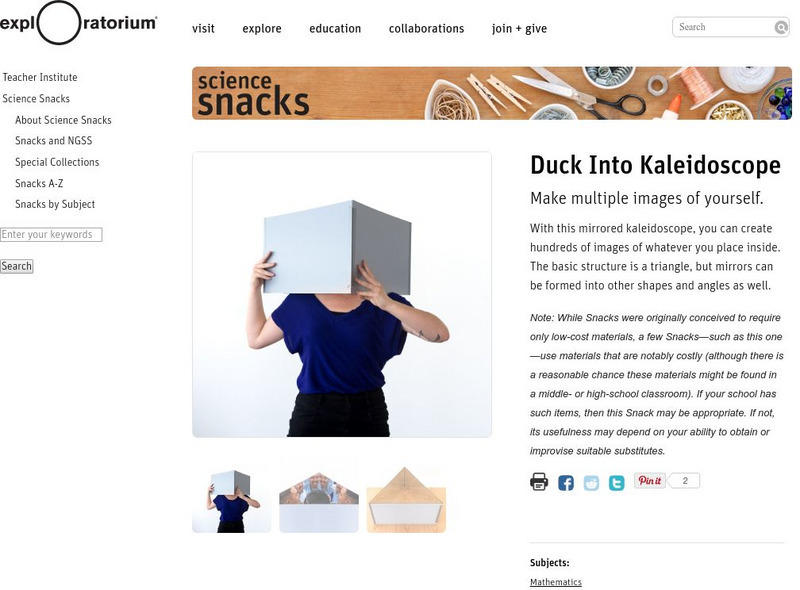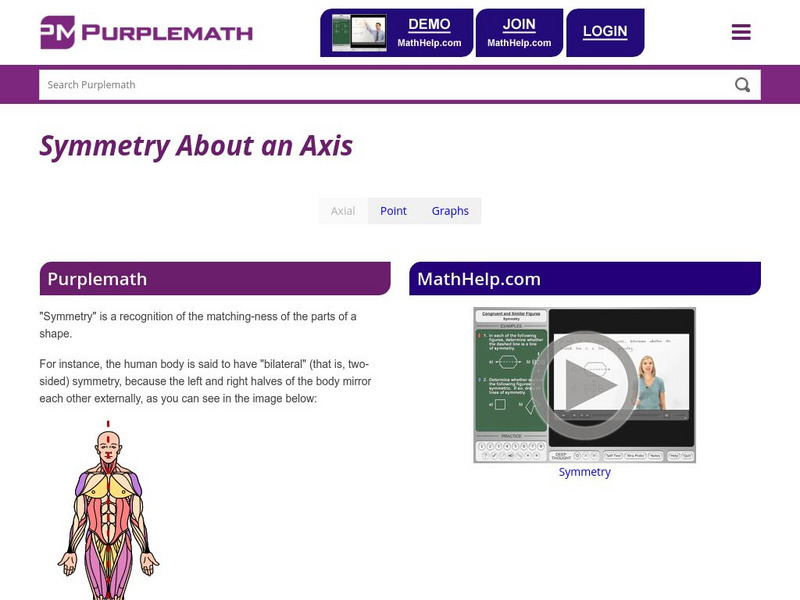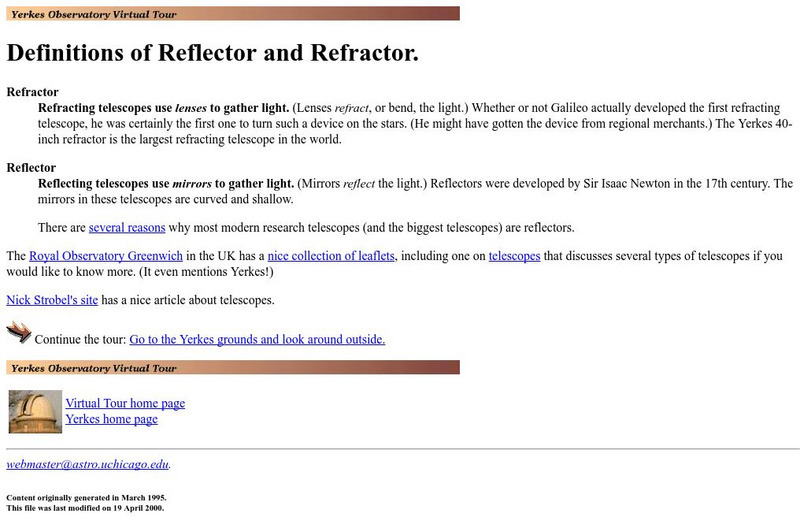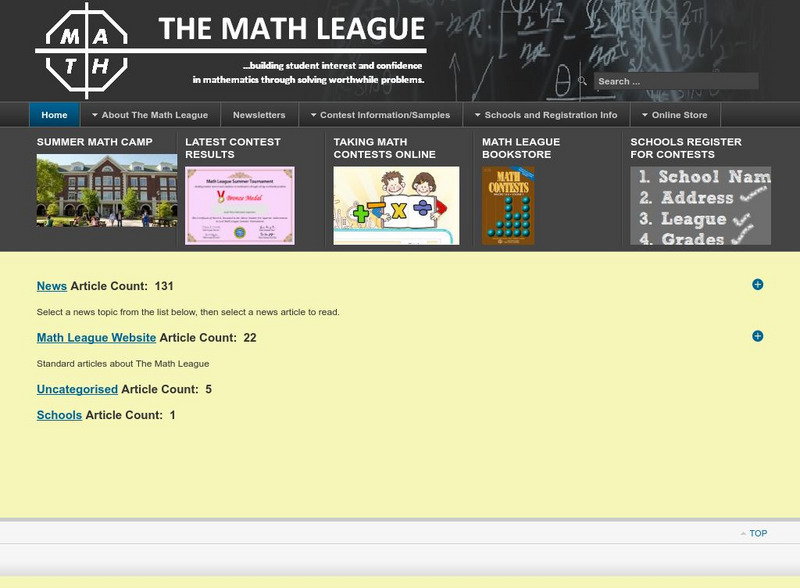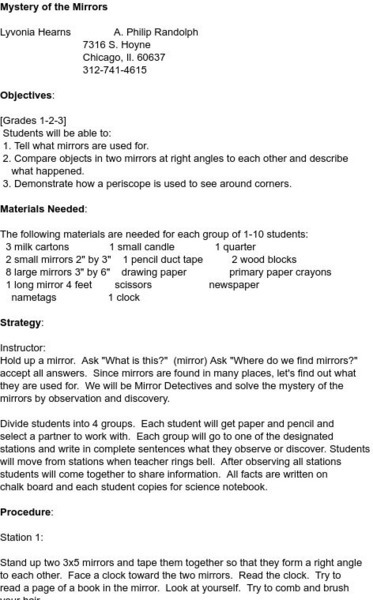Exploratorium
Exploratorium: Science Snacks: Duck Into Kaleidoscope
Create hundreds of images of yourself in this activity by making a mirrored kaleidoscope.
Exploratorium
Exploratorium: Science Snacks: Hot Spot
An activity that will help students understand properties of mirrors by using a heater. Find the focal points by examining where the heat can be felt.
Physics Classroom
The Physics Classroom: Image Formation for Plane Mirrors
Scroll down to Lesson 2 for a tutorial on image formation in plane mirrors. The tutorial from Glenbrook South High School provides lessons on why and how an image is formed, image characteristics for plane mirrors, ray diagrams, plus more.
New Advent
Catholic Encyclopedia: Jean Bertrand Leon Foucault
A lengthy biographical sketch from The New Advent of Jean-Bertand-Leon Foucault (1819-1868 CE) physicist and mechanician. Discusses his upbringing, scientific work, major accomplishments and published articles. Please note that "The...
Other
The Disgustoscope
This is a resource to teach optics, while building a modified kaleidoscope that will provide 3-dimensional images.
National Council of Teachers of Mathematics
The Math Forum: Line Symmetry
This site from The Math Forum is a great site if you are looking for activities to engage your students in learning about line symmetry. Peruse this collection of activities for one or two or four that would be right for your students....
Purple Math
Purplemath: Symmetry About an Axis
Explains symmetry about a line, using animations to illustrate the "rotation" or "reflection" involved in this type of symmetry.
Physics Classroom
The Physics Classroom: Reflection and Ray Model of Light: Spherical Aberration
An illustrated physics tutorial which explains the spherical aberration, an intrinsic defect with any mirror that takes on the shape of a sphere.
Physics Classroom
The Physics Classroom: Reflection/ray Model of Light: Ray Diagrams Convex
Students learn two rules of reflection as it has to do with convex mirrors. These two rules will greatly simplify the task of determining the image locations for objects placed in front of convex mirrors.
Physics Classroom
The Physics Classroom: Reflection/ray Model of Light: The Mirror Equation Convex
While a ray diagram may help one determine the approximate location and size of the image, it will not provide numerical information about image distance and image size. To obtain this, students are introduced to the Mirror Equation and...
Purple Math
Purplemath: Function Transformations
Generally, translation involves only moving the graph around. Squeezing or stretching a graph is more of a "transformation" of the graph. But these two topics are usually taught at the same time, and usually under the same name. Just be...
Boston University
Bu: Optics: Geometric Optics
Several short descriptions of demonstrations which illustrate principles of geometric optics (many of which focus upon refraction).
University of Chicago
University of Chicago: Reflector and Refractor
From the Yerkes Observatory Virtual Tour web site. Compares and contrasts reflecting and refracting telescopes. A link from the page leads to a second page which explains why most modern research telescopes are reflecting telescopes.
Science and Mathematics Initiative for Learning Enhancement (SMILE)
Smile: Plane, Concave, Convex Mirrors (Intermediate)
This lesson plan describes a demonstration with mirrors to catch the interest of students. Should be used with intermediate or middle school students.
The Math League
The Math League: Symmetric Figure
This tutorial features several examples of symmetric figures to explain how the line of symmetry works.
Other
Ic Teachers: Line or Reflective Symmetry
This website will provide you with a quick review of line or reflective symmetry. It also has questions and answers to help you understand line/reflective symmetry.
University of Cambridge
University of Cambridge: Nrich: Happy Halving
On this one page website expand your logic, symmetry and pattern recognition knowledge while working on this challenge. The solution is available to double check your solution.
Science and Mathematics Initiative for Learning Enhancement (SMILE)
Smile: Mystery of the Mirrors (1 3)
This lesson plan from the Illinois Institute of Technology incorporates observation with hands on activity through various stations.
Optical Society
Optical Society of America: Optics for Kids: Mirrors & the Law of Reflection
A simple activity to investigate how light reflects off a flat surface, a convex one, and a concave one. With a link to an article on reflection.
Optical Society
Optical Society of America: Optics for Kids: Mirrors and Images
An experiment to investigate how many images appear as the angle between two hinged mirrors is increased. Accompanied by an explanation of what is happening, questions for students to consider, and a link to an article about reflection.
My Science Site
Bj's Science: Microscope Word Search [Pdf]
Site provides a helpful word search teachers can use to help their students familiarize themselves with a microscope and have some fun at the same time.
Curated OER
[3 Tapered Mirrors Attached Edge to Edge]
This is a site for getting students looking at their world - and teaching optics at the same time. Students build a modified kaleidoscope that will provide 3-dimensional images. Fun site.
Curated OER
[Plan of One Side of D Scope Mirror]
This is a site for getting students looking at their world - and teaching optics at the same time. Students build a modified kaleidoscope that will provide 3-dimensional images. Fun site.


